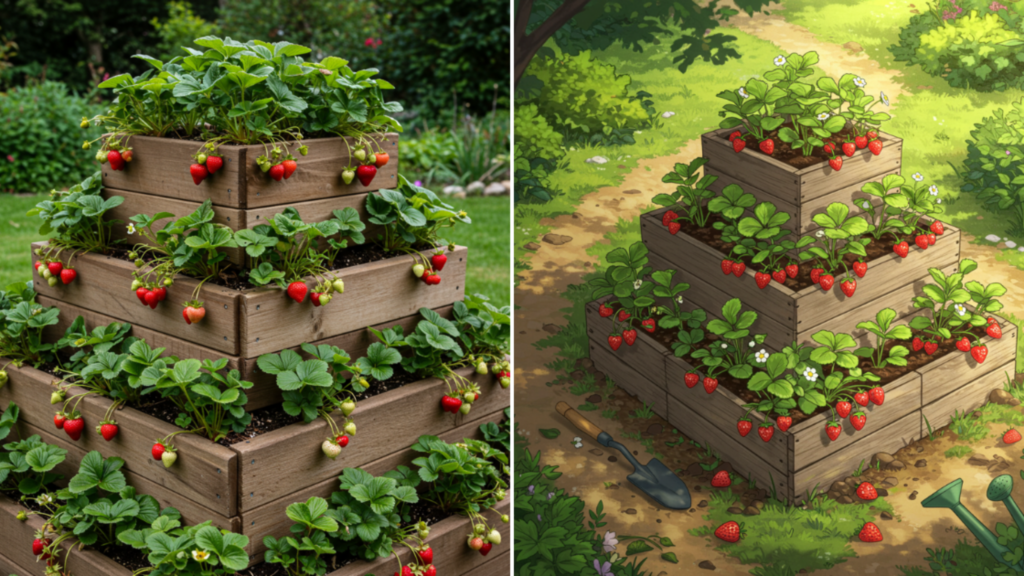If you adore strawberries but find space in your garden limited, you’re not alone. Luckily, there’s an innovative solution to this common dilemma: the strawberry pyramid planter. Not only does this creative structure allow you to cultivate more strawberries in a compact area, but it also adds a delightful visual element to your garden or balcony. In this guide, we will walk you through the process of designing and constructing your own strawberry pyramid planter while ensuring you maximize both yield and aesthetics.
Why Choose a Strawberry Pyramid Planter?
Opting for a strawberry pyramid planter comes with numerous advantages:
- Space Efficiency: This vertical planter is perfect for small areas, such as balconies or limited garden spaces, allowing you to maximize your planting area.
- Effective Watering: The tiered design ensures that water is uniformly distributed across all plants, promoting healthy growth.
- Pest Control: Elevating your plants reduces their exposure to ground pests, such as slugs and snails, which can wreak havoc on your strawberry crop.
- Visual Appeal: A pyramid planter serves as a charming centerpiece, filled with lush green plants and vibrant strawberries that beautify any outdoor space.
Step-by-Step Guide to Constructing Your Strawberry Pyramid Planter
- Design Planning:
Start by visualizing the size and number of tiers you want for your pyramid. Consider the following factors:
- Available Space: Ensure your planter will fit comfortably within your garden or patio area.
- Plant Capacity: Estimate how many strawberry plants you aim to grow, keeping your desired yield in mind.
- Material Selection: Choose sturdy materials like untreated wood, metal, or stone that can withstand outdoor conditions. A popular three-tier design typically accommodates 20 to 30 strawberry plants while remaining manageable.

- Gathering Necessary Materials:
Collect the following supplies to get started:
- Wooden planks or boards (dimensions based on your design)
- Screws or nails
- A saw and drill
- Measuring tape and a level
- Landscape fabric or a weed barrier
- A nutrient-rich, well-draining soil mix
- Strawberry seedlings or runners
- Constructing the Pyramid:
Follow these steps to build your planter:
- Step 1: Create the Base
Cut the wood into square pieces to form the base, about 4 x 4 feet in size. Secure the pieces together using screws or nails and line the bottom with landscape fabric to deter weeds and enhance drainage. - Step 2: Build the Tiers
Cut progressively smaller square pieces for the upper tiers, such as 3 x 3 feet for the second tier and 2 x 2 feet for the top tier. Stack these tiers securely on top of one another, aligning them carefully and using a level to ensure everything is straight. - Step 3: Fill with Soil
Add a rich soil mixture to each tier, combining compost, topsoil, and sand to ensure it drains well. The ideal soil pH for strawberries is around 5.5 to 6.5, maintaining slight acidity. - Step 4: Plant the Strawberries
Arrange strawberry seedlings or runners around the edges of each tier, leaving enough space—approximately 12 to 18 inches apart—for healthy growth and optimal fruiting.
Tips for Enhancing Strawberry Production:
- Lighting: Position your pyramid in a location that receives 6 to 8 hours of sunlight daily, essential for robust strawberry growth.
- Watering Techniques: Keep the soil consistently moist but avoid saturation; a drip irrigation system can help manage this efficiently.
- Fertilization: Use a balanced fertilizer during the growing season, steering clear of excessive nitrogen, which can lead to lush foliage but minimal fruit.
- Mulching: Apply a layer of straw or mulch around the plants to help retain moisture and deter weed growth.
Ongoing Maintenance and Care:
Regular pruning is vital for directing energy towards fruit production. Remove dead leaves and spent runners to keep the plants healthy. Implement pest management strategies by using netting or mesh to shield the strawberries from birds and unwanted pests. Watch out for common issues like powdery mildew and treat any signs of disease with organic solutions. In colder regions, remember to insulate your pyramid planter during winter to protect the plants from frost damage.
Why Strawberry Pyramid Planters Are a Game-Changer:
Creating a strawberry pyramid planter is not only practical; it’s a transformative way to maximize your gardening experience, especially in limited spaces. This clever structure fuses functionality and beauty, enabling you to harvest a surplus of strawberries while simultaneously enhancing your garden aesthetics. Whether you are dealing with space constraints or simply seeking a unique planting solution, a pyramid planter will allow you to cultivate more strawberries effortlessly.
Are you excited to


Greetings! This is my first visit to your blog! We are a group of volunteers and starting a new project in a community in the same niche. Your blog provided us valuable information to work on. You have done a marvellous job!
510626 302966Quite interesting topic , thanks for posting . 101164
Great blog! Is your theme custom made or did you download it from somewhere? A theme like yours with a few simple adjustements would really make my blog shine. Please let me know where you got your design. Bless you
Klassiker für Mr Green Kenner wohl zweifellos auch Gonzos Quest, Fire Joker,
Legacy of Dead und der Slot Apollo God of the Sun. Einige unserer beliebtesten Slots sind Book of Dead, Gates of Olympus, Bigger Bass Bonanza,
Eye of Horus, Millionaire Genie und sämtliche Megaways-Slots.
Einige Slots haben online auch mehr Funktionen als im klassischen Las Vegas Casino.
Auch die iOS native Slots App, die Sie im App Store downloaden können, bietet Ihnen alle Slots von allen Spieleherstellern. Die mobile Browserversion bietet Ihnen dieselbe große Auswahl wie die Desktop-Version von Mr
Green.
Was ich am besten find ist einfach auf die Seite gehen und
los legen ohne auswählen zu müssen ob im Browser spielen oder Downloaden. Ich selbst bin da schon ewig angemeldet und es macht auch
immer wieder spaß dort zu spielen. Bei den sogenannten Drops & Wins Turnieren kann man in der Regel ausgewählte Slots von Pragmatic Play spielen und
mit viel Glück Bargeldpreise gewinnen.
Wenn du gewinnen willst spielst die No-Name Games.
“Armutszeugnis für mr green”GENIERT euchwette nur
mehr bei Bet 365 und bwin… Bitte spielt nicht,ehrlich spielt bei
win2day oder egal wo nicht bei Mr.green!!!! Von Anfang an gewinnt bisher aber dann bist ordentliche Verluste…Nach hunderte und hunderte
Euro hast apsolut keine Gewinn…Ich warne jeden bitte Finger weg von Mr Green casino !
Ich habe moon princes gespielt mit 20cent Einsatz,ich habe nichts aber überhaupt nichts gewonnen,
es gibt keine… Schlechtes casino.
References:
https://online-spielhallen.de/die-mobile-leon-kasino-app-ihr-glucksspielportal-fur-unterwegs/